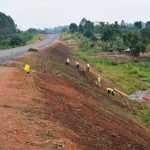As Uganda continues to invest in road and urban infrastructure, flooding and poor drainage remain serious challenges. Effective hydrology and hydraulics design isn’t just about engineering—it’s about protecting lives, property, and investment.
The Role of Drainage in Infrastructure:
Poorly designed drainage leads to road failure, erosion, waterlogging, and environmental degradation. Mlimani Associates emphasizes the use of return period analysis, hydrological modeling, and site-specific rainfall data to size culverts, channels, and side drains properly.
Our Approach at Mlimani:
We apply both inlet and outlet control criteria in our culvert designs, often with a headwater-to-depth ratio (Hw/D) of 1.2, ensuring systems can withstand 25–50-year storm events. For urban areas, we design rectangular storm drains, while in rural areas, we prefer trapezoidal channels to optimize cost and flow.
Conclusion:
By integrating smart drainage design with modern hydrological tools like HEC-RAS and GIS, we help build roads and structures that last longer, reduce maintenance costs, and serve communities better. At Mlimani Associates, resilience starts with good design.



